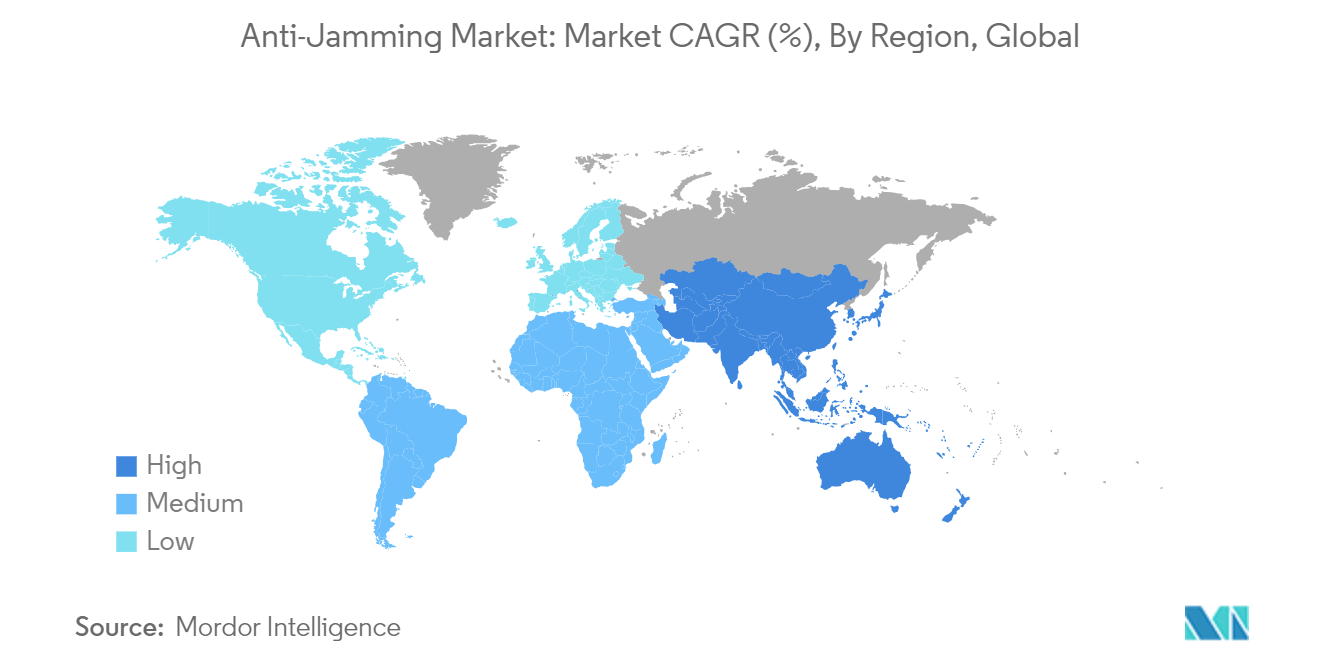Market Trends of Anti Jamming Equipment Industry
Defense Holds Major Share
- The growth of GPS technology in military applications is driven by the need for precision, real-time situational awareness, secure communication, the increasing use of autonomous systems, and the constant threat of electronic warfare. As military technology evolves, GPS remains a critical enabler of modern defense operations, fueling further demand for advanced GPS systems.
- Ongoing conflicts have increased the demand for anti-jamming systems due to the growing use of unmanned systems for casualty evacuations. These systems are crucial for military operations, making it essential to protect them from interference. Anti-jamming technologies mitigate jamming risks, ensuring the reliability of unmanned systems in casualty evacuations.
- Substantial growth opportunities arise from the high demand for durability and resistance to enemy technology in military applications. This demand primarily focuses on unmanned aerial vehicles (UAVs) for surveillance, reconnaissance, and combat operations. Additionally, there is a need for munitions, guided systems, and cost-effective GPS anti-jamming solutions.
- The use of autonomous military systems like drones, unmanned ground vehicles, and robotic systems is increasing. These systems depend heavily on GPS for navigation and mission execution. In contested environments, jamming or spoofing GPS signals could disable or mislead these systems. Anti-jamming equipment protects these autonomous platforms and ensures their operational effectiveness. According to IFR, spending on military robotics is anticipated to rise by USD 16.5 billion by 2025.
- Many countries are modernizing their military forces and integrating advanced GPS technologies for better operational capabilities. As part of these modernization programs, governments invest heavily in anti-jamming solutions to protect GPS-reliant systems such as missile guidance systems, command and control (C2) infrastructure, surveillance, and intelligence-gathering platforms. This increasing investment is driving the growth of the anti-jamming market in the defense sector.

Asia Pacific to Register Major Growth
- China's swift economic growth and integration into the global landscape have deepened its reliance on dependable navigation and communication systems. The transportation and logistics sectors, heavily dependent on GPS and satellite-based navigation, utilize these technologies for route optimization, cargo tracking, and ensuring the smooth transit of goods and individuals. Thus, both public and private sectors are prioritizing investments in anti-jamming solutions.
- In February 2024, Chinese scientists unveiled electronic warfare (EW) equipment capable of swiftly detecting, decoding, and neutralizing enemy signals. It empowers the People’s Liberation Army (PLA) to effortlessly monitor signals within the gigahertz range, including frequencies utilized by amateur radio. Moreover, the equipment boasts signal processing chips and AI integration, bolstering China's capacity to counteract jamming and ensure uninterrupted communication.
- The increase in the defense budget has prompted the government to enhance its defense capabilities and to implement additional anti-jamming technology to bolster national security. In addition to defense advancements, Japan's aviation sector is experiencing notable expansion. This industry necessitates the development of potential jammers to disrupt the GNSS signals of aircraft, which is becoming essential for navigation, targeting, and reconnaissance operations where dependability is crucial.
- The anti-jamming equipment market presents significant growth opportunities, driven by heightened investments in research and development and an increasing demand for anti-jamming solutions across diverse sectors. For instance, in December 2023, Israel Aerospace Industries (IAI) signed a contract with Korea Aerospace Industries (KAI) to provide its ADA system for the Light Armed Helicopter (LAH) program. As part of this agreement, IAI will provide its ADA system, a GPS Anti-Jamming solution designed to mitigate interference from multiple jammers from various directions.


